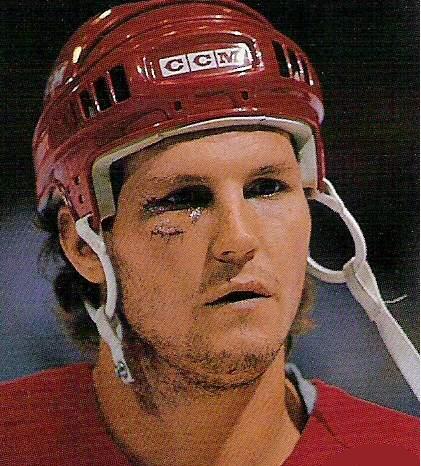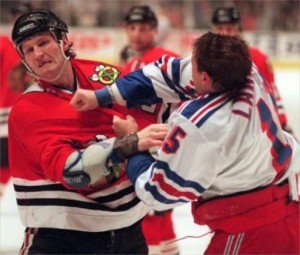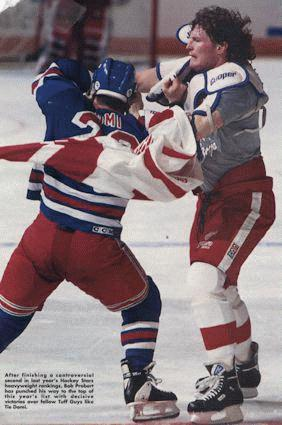This hurts.
R.I.P. Probie.
Quick tally: #24, over 3,000 penalty minutes. Member, along with Joe Kocur, of the legendary “Bruise Brothers” tandem back in the days when the Detroit Red Wings were more feared for what they could do after the whistle stopped play. Participant in a handful of the all-time classic fights in hockey history. Man who inspired t-shirts that read “Give Blood. Fight Probert.” Simply put, if one were to try and create the ideal enforcer (especially for an era that may not have been the toughest or most iconic era but was one of the most enjoyable), one could hardly imagine a more suitable cartoon character than Bob Probert.
As The Kinks once sang, Let’s All Drink To The Death Of A Clown.
And lest anyone think I’m using the word clown carelessly or disrespectfully, it is in fact chosen with the aim of being both accurate and approbatory. (A Probie-tory, if you like.)
Think about what a clown does: he is the minor but essential character who shows up at a circus with the objective of instigating misconduct. Above all, his purpose is to entertain with a mixture of mischief and cheer. A superficial assessment might conclude that a clown is simply doing, in make-up, what any drunk idiot might do. But of course whether it is juggling, dancing or doing tricks, not just anyone could be (or would want to be) a clown. It’s a job.
Think about what a hockey enforcer (what we used to call a goon just like we used to call escorts hookers or stockbrokers sociopaths) does: he is the minor but essential figure who shows up in an arena with the object of instigating misconduct (hopefully without receiving a game misconduct). Above all, his purpose is to settle scores and entertain a crowd while enervating his teammates. A superficial assessment might conclude that an enforcer is simply doing, in a colorful costume, what any drunk idiot might do. But needless to say, trading bare-fisted blows (sober or especially drunk) in a bar is considerably different than standing on skates and going toe to toe with an opponent who is well-prepared (and in some cases, well-paid) to kick your ass in front of thousands of people. Many people without athletic ability are very capable goons; only an extremely select group of individuals are able (much less willing) to abide by “The Code”. It’s a job.
It’s difficult to talk intelligently with anyone about hockey because so few people watch (or care) about it. That goes double when trying to articulate the science of sanctioned pugilism. How can one possibly rationalize or defend the spectacle of adults engaging in behavior that would get them arrested out in the streets? (Indeed, fans are arrested nightly at hockey rinks all over the continent for imitating, albeit often drunkenly and with far less flair, the very behavior occurring in real time below them.) The answer is at once easy and complicated, like all truths tend to be. The easy part: there is no need to explain it. If you’re not a hockey player, you can’t hope to comprehend it; unless you are a fan, you have no hope of understanding or appreciating it. It’s really that simple. Seriously. Just ask a hockey player. (And, as perspicacious commentators have pointed out for decades, one notices how nobody gets up to grab popcorn once a fight breaks out. While that may speak volumes about the distressing devolution of our species and our insatiable appetite for violence, there is something a bit more sophisticated going on.)
So what is complicated about it? For starters, hockey fighting remains a diversion that people who genuinely deplore violence (like this writer) endorse and get excited about. What does that say about us? I’m not certain. But I do know that unlike the “real” world, it is exceedingly rare for two hockey combatants to enter the fray unwillingly. Yes but, doesn’t that make it a great deal worse, if they do it because they get paid? (Well, is boxing beatiful? Brutal? Your opinion here will go a decent way toward explaining your ability, or willingness, to negotiate the enigmatic charm of the expression “five minutes for fighting”.) That gets to the not-so-easily explained sensibility of athletes (in general) and hockey players (in particular). Hockey players have traditionally been paid a great deal less than other athletes in more popular sports. It is, therefore, a bit ironic to consider that these players are more immune to pain and prone to play a regular season game like the world is on the line. It is, for hockey fans, refreshing that the players have an integrity that has been ingrained from generations and is remarkably resilient against the corrupting forces of salary, fame and product endorsements. Put in less exalted terms, people tend to get (understandably) cynical when, say, a baseball player with a multi-million dollar annual contract goes on the D.L. with a strained hamstring. That type of commonplace indifference is especially noticeable –and appalling– when one realizes that hockey players routinely return to the ice moments after receiving stitches, or losing teeth, or suffering bruised (and in some cases, broken) bones. Google it if you don’t believe me.
None of this is to say that one might enjoy the sport more if one learned more about it, but a casual viewer (or hater) might be genuinely surprised to learn a few things about the history of hockey fighting. For starters, the opposing players seldom hate each other and in it is not uncommon for them to be friends off the ice (particularly if they are old teammates). Also, the aforementioned code does have a rather elaborate –and universally endorsed– system for the rules of engagement. Finally, and perhaps most significantly: not only are enforcers generally the most popular players (amongst the fans; amongst the teams), they tend to be some of the more thoughtful and soft-spoken ones. (For two obvious examples, consider the ever-humble Craig Berube –“The Chief”– who toiled many seasons in the NHL including for my hometown Capitals and now is an assistant coach for the Flyers; then there is George McPhee who happens to be one of the more respected and successful GMs in the game.)
Of course, not all of them are model citizens, and for a variety of reasons (some understandable, some inscrutable), some of them have had very challenging and troubled lives.
Enter Bob Probert. Though it is debatable whether or not he (or any particular player) was “the best” enforcer in the history of organized hockey, not many people would argue with any credibility that he is not at least in the Top 10. For my money, pound for pound and in terms of longevity, respect, quality of opponents and success, Probert is the preeminent knuckle artist of the modern era.
Let the cliched encomiums unfurl: he feared nobody. He fought everyone. Ultimate warrior. Ideal teammate. Crowd pleaser. Accomplished actor? Well, see below:
As Detroit (and Chicago) residents know, and as fans of the game remember, Probert battled the proverbial demons off the ice as well. His struggles with alcohol and substance abuse is amply documented. His occasional escapades drew the attention of law enforcement officials. He was, in short, a troubled man in certain ways, but he was always resilient, and never let his addictions keep him down (or out).
(The actual history of his difficulties is sufficiently reported that folks interested in more can easily find out with the click of a mouse. I also acknowledge that his livelihood may have done as much to exacerbate his issues as it did to ameliorate them. In other words, he quite possibly may have gone down certain roads whether or not he played hockey or threw a single punch. But I readily concede that there is an ugly side to sports, just like there is a sinister side to life, and all of us are constantly pushed and pulled by the momentum of necessity and choice, and the inexorable reality that we have to pay bills and obey laws. A more sustained –and serious– discussion of sports, hockey, hockey fighting and some of the casualties of this game (think John “Rambo” Kordic’s tragic story) should occur at another time.)
For now, in addition to wishing him a fond adieu and sincerely sending out support and goodwill to his family and friends, I’d like to celebrate some of the most memorable instances of him doing what he did better than just about anyone who ever laced up the skates.
1. Bob Probert vs. Craig Coxe (Round One):
2. Bob Probert vs. Craig Coxe (Round Two):
3. Bob Probert vs. Dave Semenko:
4. Bob Probert vs. Troy Crowder:
5. Bob Probert vs. Tie Domi (The Epic Saga):
**Bonus: It might make sense to go ahead and include, just for the heck of it, THE BEST HOCKEY FIGHT OF ALL TIME**
Bob Probert vs. Marty McSorley (Two of the best of their generation in a game called by the best hockey announcers of their generation, Gary Thorne and the immortal and inimitable Bill Clement):
If he had kept his act together a little better, he would have retired a Red Wing, possibly kissed the Cup, and pretty much owned the Motor City. Somebody could make a movie like that. Of course, somebody already did: his name was Bob Probert and the movie was his life. Not all movies have happy endings, alas. And like anyone who will be missed once they are gone, he gave us far more than we ever gave him.



